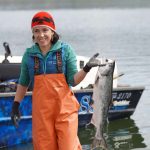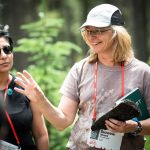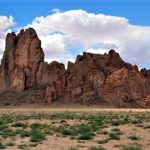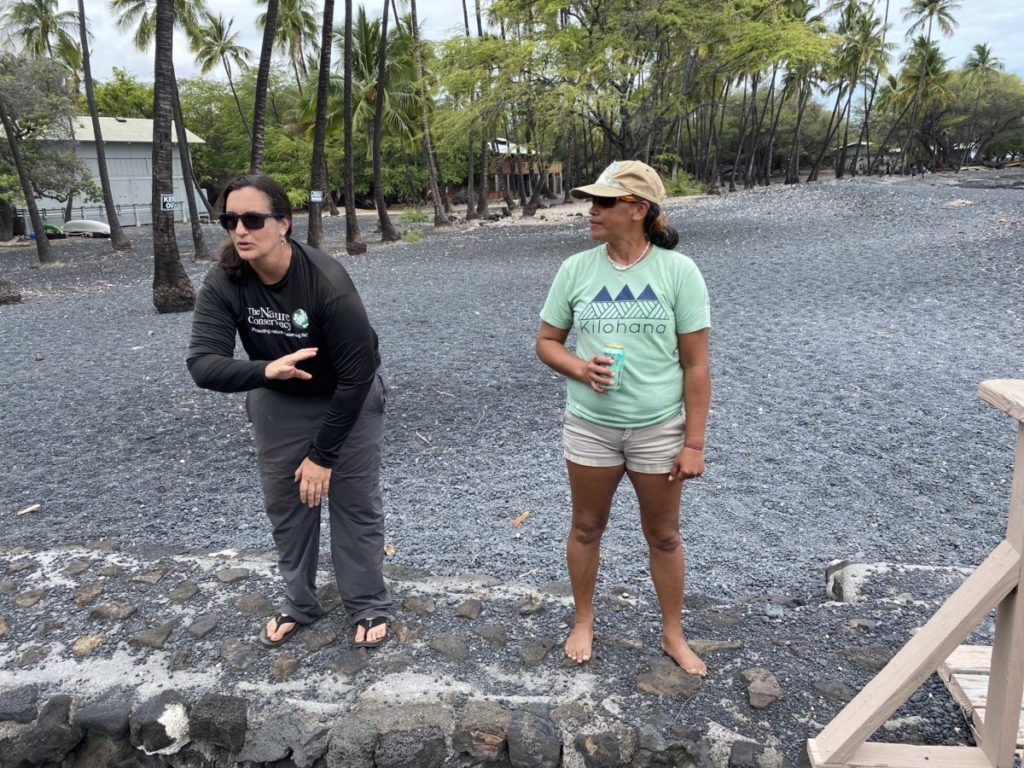
Rebecca Most and Lehua Kamaka greet each other in the Hawaiian tradition: hands clasped tenderly around one another’s faces, foreheads touching, eyes closed, sharing breath. It’s aloha in the way it was always supposed to be used.
Most and Kamaka are unusual friends. Most is an American biologist for The Nature Conservancy, who grew up in California. Kamaka is a native Hawaiian, a lineal descendant of those who once cared for the Kiholo Royal Fishponds whose skills come from ancient ancestral knowledge.
But once a month, they meet at the Fishponds, which sits on the shores of the North Kona Coast, in Hawaii’s Big Island. Over their years of working together to painstakingly count and categorize the fish in these ponds, they have developed a friendship so deep that they no longer need words to communicate. When they’re swimming in their figures of eight, zigzagging through the chilly waters, they know what the other is thinking.
Their work has made a tangible impact on the biodiversity of the pond: Since 2012, they have seen a tenfold increase in fish that they are raising to feed the community, as well as an increase in the number of fish species–from 19 to 36. It’s also made an impact culturally, too. The pair record data using modern scientific techniques blended with ancient Hawaiian knowledge – and have used the data they’ve obtained to win protections for the ponds, which are of tantamount importance to the native Hawaiian community.
This idea of collaboration by science organizations with communities has been talked about a lot, Most explains, but has been mostly aspirational until recently. “It’s a paradigm shift from traditional Western and colonial conservation management to a real-time integration of a living culture and people into land use and resource management,” she says.
Kamaka agrees.“We now speak the language [of the white Western world],” she explains. “Before we couldn’t do it in our voice. Now we have the paperwork, the numbers, the science, we are a bigger force. And there are other places in Hawaii that are learning from our model.”
A Pond Steeped in History
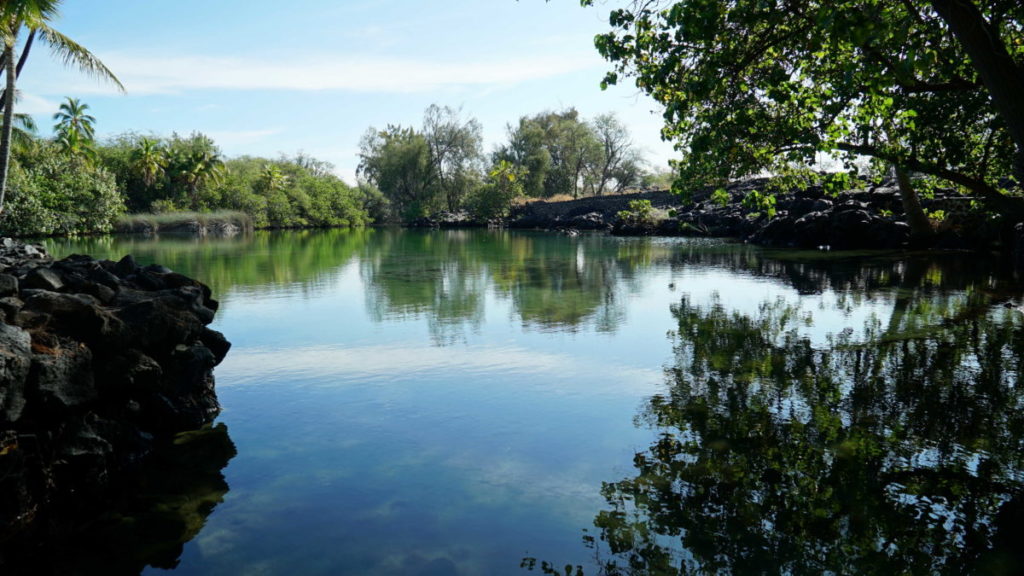
The Kiholo Royal Fishponds are a cultural touchstone for native Hawaiians, providing a precious connective cord to their ancestors.
Before the US staged its coup in 1893, the archipelago was ruled by a monarchy. Fishponds, which were dotted along the coastlines, were a central part of the Hawaiian way of life, and a complex aquaculture system that provided food for communities. Kīholo fishponds were particularly special, providing pools that had distinct functions–everything from fresh drinking water to growing food for the great chief aliʻi King Kamehameha I.
Filled with valuable freshwater that bubbles up from the ground, and ocean water rushing in from the sea, between three and five million gallons flow through the fishponds every day, exiting into the sea, providing a valuable cooling system for nearby coral reefs. For generations, the stewards of Kīholo have carefully observed the ecological cycles in the pond, and those observations guide sustainable harvesting to feed the community. During the 1980s, the fishponds fell into disrepair, suffering from neglect, careless tourists driving SUVs through the sacred spots, and poaching.
In 2011, this historical treasure, which was privately owned by legendary hair stylist Paul Mitchell, was donated to conservation nonprofit The Nature Conservancy, and work to painstakingly restore the 3.2-acre ponds began.
The organization partnered with Hui Aloha Kīholo, a local group that tirelessly works to protect the Kīholo Bay area. Its employees, like Kamaka, are stewards–or kahu–of the land. When co-management of the fishpond began with TNC and Hui Aloha Kīholo, it was in a dire state. For decades, descendants of the Hawaiians who had once cared for the pond were barred from entering the areas their ancestors had once freely frequented. Now, they have full access to collaboratively care for their ancestral homeland.
Most and Kamaka met, and began working together to come up with a plan to bring the fishponds back to life. “A lot of the work here is restoring this fishpond and bringing it back to a place of abundance,” says Most. “Our overarching goal is for it to be a place that can feed the community once again.”
It was a difficult process for Kamaka, though. The area had been surveyed by scientists before, who took without giving back.
“It was hard at first,” Kamaka says as she walks across the hot black sand that separates the cool gray ocean from the aquamarine ponds. “Scientists would demand access to the area, come in, do their work and then they’re gone. And they would leave trash behind for us to clear up.”
When The Nature Conservancy asked Hui Aloha Kīholo what they wanted for the future of the fishpond, however, Kamaka realized these scientists were different. Work on the fishponds began in 2012. Rock walls were repaired by hand, weeds removed, sediment sucked out via a mechanized pump, and invasive species caught and removed. Over the years, thousands of volunteers have come to help care for the ponds and rebuild large sections of the pond walls. “Rebecca and the TNC have shown us a completely different perspective on [Western] science,” Kamaka adds. “They have opened my mind to science.”
Unexpected Benefits
After almost a decade of work, the pair realized their meticulous efforts were paying off. Now there are enough fish in the ponds to carry out small harvests for ceremonial and special events, although there is still some way to go before locals can regularly fish at the ponds just like their ancestors did all those years ago.
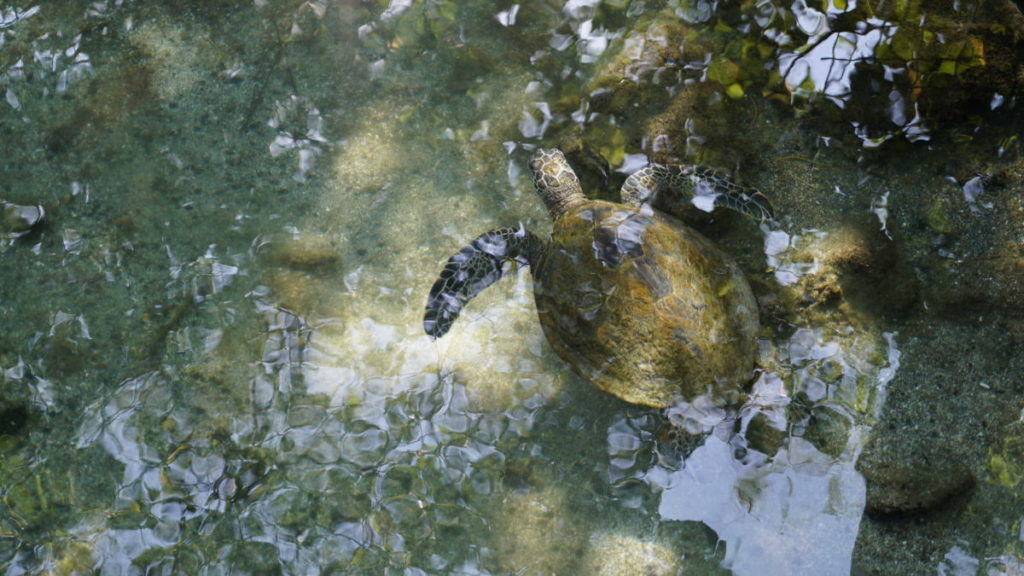
But there has been one more unexpected benefit to the work. Over their years of working together to painstakingly count and observe the fish in these ponds, Most and Kamaka have developed a deep and meaningful relationship that transcends any perceived differences.
At one point during the site visit, Kamaka’s niece Hāweo clambers onto Most’s lap. They are as close as if they were related by blood. Their friendship has not only helped restore the fishpond, and several fish species, but is a reflection of the time caring for Kīholo with mutual respect for each other’s perspectives.
“Our stewardship is only possible because of the knowledge of the lineal descendants,” Most adds, “and it guides every step in our collective work to care for this place. Everything we do here is by, for, and with the community.” The ultimate goal is ponds that are culturally appropriate and can be sustainably used, while also benefiting nature.
Both Most and Kamaka hope that this approach of community co-management can be modeled elsewhere, both on other Hawaii islands, such as Maui, and perhaps further afield where indigenous populations are struggling to protect their resources – everywhere from South America to Indonesia. The diverse perspectives and skills each brings to the stewardship of the ponds, where traditional knowledge systems are integrated with contemporary fisheries management, can provide the protection the planet so urgently needs. ◼
The Story Exchange is currently seeking submissions for its annual Women In Science Incentive Prize, awarding a total of $25,000 to 5 female scientists working to improve air quality and protect health. Deadline for submissions: July 31.


